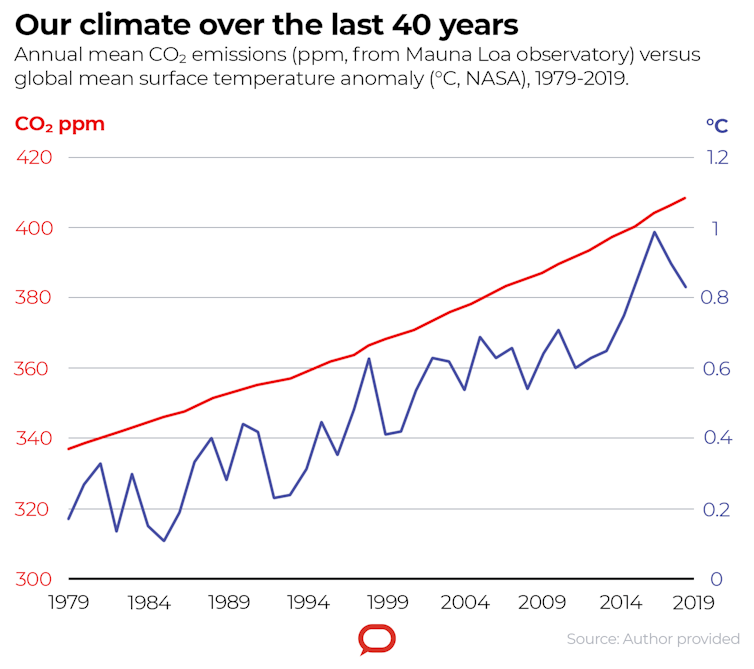What Scientist Got Right About Climate Change Decades Ago
This month the world has been jubilant the 50th anniversary of Neil Armstrong setting foot on the Moon. Simply this calendar week sees another scientific ceremony, maybe just as important for the future of civilisation.
Forty years ago, a grouping of climate scientists sat downwards at Wood Hole in Massachusetts for the first meeting of the "Ad Hoc Group on Carbon Dioxide and Climate". It led to the preparation of what became known equally the Charney Report – the first comprehensive assessment of global climate change due to carbon dioxide.
Baca juga: What is a pre-industrial climate and why does information technology matter?
It doesn't audio as impressive every bit landing on the Moon, and at that place certainly weren't millions waiting with bated breath for the deliberations of the meeting.
But the Charney Report is an exemplar of good scientific discipline, and the success of its predictions over the by 40 years has firmly established the science of global warming.
What is this 'greenhouse gas' you lot speak of?
Other scientists, starting in the 19th century, had already demonstrated that carbon dioxide was what we at present call a "greenhouse gas". Past the 1950s, scientists were predicting warming of several degrees from the burning of fossil fuels. In 1972 John Sawyer, the head of research at the UK Meteorological Office, wrote a four-page paper published in Nature summarising what was known at the time, and predicting warming of most 0.6℃ by the end of the 20th century.
Only these predictions were still controversial in the 1970s. The world had, if anything, cooled since the eye of the 20th century, and there was fifty-fifty some speculation in the media that perhaps nosotros were headed for an ice age.
The meeting at Woods Pigsty gathered together virtually 10 distinguished climate scientists, who also sought communication from other scientists from across the world. The group was led by Jule Charney from the Massachusetts Constitute of Technology, one of the almost respected atmospheric scientists of the 20th century.
The Study lays out clearly what was known about the likely effects of increasing carbon dioxide on the climate, besides every bit the uncertainties. The main conclusion of the Report was direct:
We guess the most probable warming for a doubling of CO₂ to be near 3℃ with a probable error of 1.five℃.
In the 40 years since their meeting, the annual average CO₂ concentration in the temper, as measured at Mauna Loa in Hawaii, has increased past virtually 21%. Over the aforementioned menstruum, global boilerplate surface temperature has increased by about 0.66℃, well-nigh exactly what could have been expected if a doubling of CO₂ produces about 2.5℃ warming – simply a bit below their best gauge. A remarkably prescient prediction.

Reception of the article
Despite the high regard in which the authors of the Charney Written report were held by their scientific peers at the time, the report certainly didn't lead to immediate changes in behaviour, by the public or politicians.
Only over time, as the world has continued to warm as they predicted, the report has become accepted as a major milestone in our understanding of the consequences our actions have for the climate. The electric current ingather of climate scientists revere Charney and his co-authors for their insight and clarity.
Potent scientific discipline
The report exemplifies how good science works: institute an hypothesis after examining the physics and chemistry, and then based on your cess of the science brand strong predictions. Here, "potent predictions" ways something that would be unlikely to come true if your hypothesis and science were wrong.
In this example, their very specific prediction was that warming of between ane.five℃ and 4.five℃ would accompany a doubling of atmospheric CO₂. At the time, global temperatures, in the absence of their hypothesis and science, might have been expected to stay pretty much the same over the ensuing 40 years, cooled a bit, possibly even cooled a lot, or warmed a lot (or a footling).
In the absenteeism of global warming scientific discipline any of these outcomes could have been feasible, so their very specific prediction made for a very stringent test of their scientific discipline.
The Charney Written report's authors didn't just uncritically summarise the science. They also acted sceptically, trying to find factors that might invalidate their conclusions. They concluded:
We have tried just have been unable to discover whatever disregarded or underestimated physical effects that could reduce the currently estimated global warmings due to a doubling of atmospheric CO₂ to negligible proportions or to reverse them altogether.
The report, and the successful verification of its prediction, provides a business firm scientific basis for the discussion of what we should exercise about global warming.
Over the ensuing 40 years, as the world warmed pretty much as Charney and his colleagues expected, climate change science improved, with ameliorate models that included some of the factors missing from their 1979 deliberations.
Baca juga: Climate change or climate crunch? To really engage people, the media should talk about solutions
This subsequent scientific discipline has, yet, only confirmed the conclusions of the Charney Report, although much more than detailed predictions of climatic change are now possible.
An before version of this commodity referenced a meeting in Massachusetts. The meeting was at Forest Hole, simply not at the Woods Hole Oceanographic Institution.
What Scientist Got Right About Climate Change Decades Ago,
Source: https://theconversation.com/40-years-ago-scientists-predicted-climate-change-and-hey-they-were-right-120502
Posted by: gasparsible1980.blogspot.com


0 Response to "What Scientist Got Right About Climate Change Decades Ago"
Post a Comment